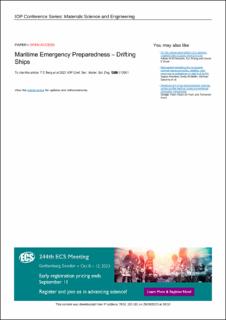| dc.contributor.author | Berg, Tor Einar | |
| dc.contributor.author | Selvik, Ørjan | |
| dc.contributor.author | Indergård, Robert | |
| dc.contributor.author | Ringen, Edvard | |
| dc.date.accessioned | 2023-09-04T10:14:19Z | |
| dc.date.available | 2023-09-04T10:14:19Z | |
| dc.date.created | 2023-08-29T08:55:02Z | |
| dc.date.issued | 2023 | |
| dc.identifier.issn | 1757-8981 | |
| dc.identifier.uri | https://hdl.handle.net/11250/3087272 | |
| dc.description.abstract | The Norwegian Coastal Administration registers maritime incidents in Norwegian waters. Drifting ships and drifting objects may cause serious incidents and possible disasters. By analysing ship traffic in Norwegian waters, it is documented that the frequency of drifting ships has been approximately 0.15% of the registered ship transits, or 150–165 drifting cases annually. In addition to a possible grounding when a vessel reaches the coastline, the increased use of the ocean space for wind farms, floating solar installations, and fish farming structures (moving from sheltered coastal sites to exposed locations) increase the risk of collision with different types of ocean structures, including offshore oil and gas installations. The need for adequate emergency preparedness to prevent drifting ships from colliding with different types of ocean structures or a final grounding can be solved through different types of mitigating measures. One measure could be to have dedicated emergency towing vessels for handling vessels drifting towards ocean structures or on a course leading to a possible grounding. A reliable tool for predicting a drifting vessel's path is important for planning an emergency towing operation. Systems to provide a fast and safe setup of an emergency towing connection under different environmental conditions are needed, while the competence of the crew on the emergency towing vessel and the ship to be towed is a critical factor for a successful emergency towing operation under adverse conditions. | en_US |
| dc.language.iso | eng | en_US |
| dc.publisher | IoP | en_US |
| dc.rights | Navngivelse 4.0 Internasjonal | * |
| dc.rights.uri | http://creativecommons.org/licenses/by/4.0/deed.no | * |
| dc.subject | Drifting | en_US |
| dc.subject | Maritime incidents | en_US |
| dc.subject | Emergency towing | en_US |
| dc.subject | Towing operations | en_US |
| dc.title | Maritime Emergency Preparedness – Drifting Ships | en_US |
| dc.title.alternative | Maritime Emergency Preparedness – Drifting Ships | en_US |
| dc.type | Journal article | en_US |
| dc.type | Peer reviewed | en_US |
| dc.description.version | publishedVersion | en_US |
| dc.rights.holder | Content from this work may be used under the terms of the Creative Commons Attribution 3.0 licence. Any further distribution of this work must maintain attribution to the author(s) and the title of the work, journal citation and DOI. | en_US |
| dc.source.journal | IOP Conference Series: Materials Science and Engineering | en_US |
| dc.source.issue | 1288 | en_US |
| dc.identifier.doi | 10.1088/1757-899X/1288/1/012001 | |
| dc.identifier.cristin | 2170421 | |
| dc.source.articlenumber | 012001 | en_US |
| cristin.ispublished | true | |
| cristin.fulltext | original | |
| cristin.qualitycode | 1 | |

